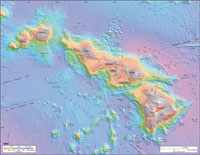|
As the Pacific Plate has been moving westward over the Hawaiian Hotspot, it has produced the Emperor Seamount Chain. The Hawaiian Islands are at the eastern end of the chain, and are the youngest (Figure 297). Volcanoes on the Big Island (Hawaii) and Maui have erupted in historic times. Mauna Loa is a massive shield volcano on Hawaii that rises from ocean depths to its peak of 13,678 feet, making it is the tallest mountain on Earth (Figure 298). Hawaii's volcanoes are the most active on the planet. Big Island eruptions have been proceeding nearly continuously since 1983. The eruptions are generally gentle (not explosive like volcanic arc eruptions in the Cascades or Alaska), the basaltic lava is extremely hot, and therefore flows long distances, often spilling into the ocean. The lava builds up shield-shaped volcanic cones (Figures 299 to 301). When the volcanoes stop erupting (after they move off the hotspot magma source) erosion takes over, wave erosion carves massive sea cliffs on the windward side of the islands (such as the Na'Pali Coast on Kawaii, Figure 302). Mt. Waialeale on Kauai gets about 460 inches of rain a year, making it the wettest place in the United States. |

Fig. 297. Map of Hawaii showing topography and bathymetry. The islands are on the east end of the Emperor Seamount Chain. The Hawaiian Hot Spot is underneath the Big Island. |

Fig. 298. Mauna Loa is a massive shield volcano on Hawaii and from ocean depths to its peak of 13,678 feet is the tallest mountain on Earth. The summit is in Hawaii Volcanoes National Park. |

